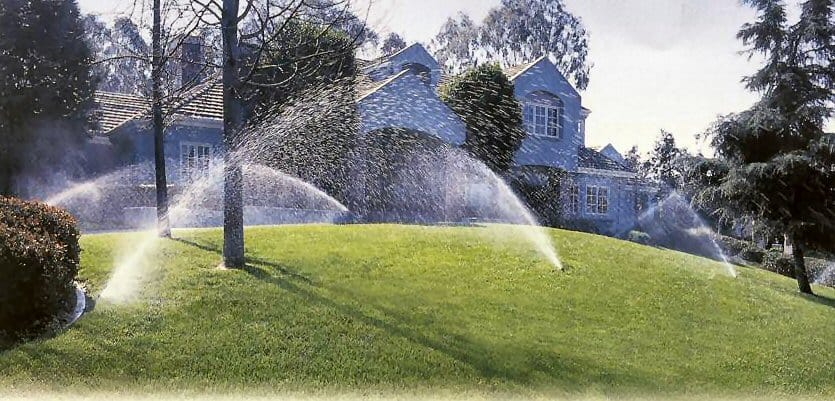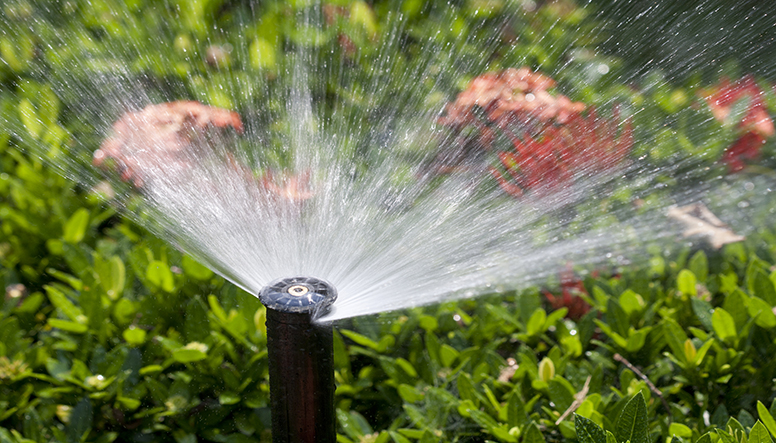Checking out the A Lot Of Usual Troubles in Sprinkler Systems and Their Repairs
Automatic sprinkler are important for keeping healthy and balanced landscapes, yet they often run into various issues. Usual concerns consist of blocked nozzles, busted pipes, and unequal watering patterns. Each of these can considerably influence system efficiency and water efficiency. Recognizing these troubles and their solutions is crucial for any homeowner. The following areas will certainly lay out typical challenges and the essential fixings to maintain a lawn sprinkler system working at its best. What follows might amaze those unprepared for maintenance realities.
Clogged Nozzles and Lawn Sprinkler Heads
Clogged nozzles and sprinkler heads prevail problems that can substantially prevent the performance of a lawn sprinkler. With time, particles such as dust, mineral, and algae accumulation can build up, obstructing water flow and bring about unequal coverage in the lawn or garden. This can result in specific areas getting not enough water, while others may become over-saturated.
Normal maintenance is crucial to prevent these obstructions. Regular checks can identify any kind of obstructions, and cleansing can often be accomplished with easy tools like a small brush or a toothpick. Sometimes, soaking stopped up elements in vinegar can assist dissolve natural resource.
For severe blockages, replacement of the nozzle or head may be required to recover correct feature. Addressing these concerns promptly guarantees that the automatic sprinkler runs efficiently, maximizing and preserving a healthy landscape water usage.
Broken Piping and Leaks
Busted pipelines and leakages can considerably interrupt the performance of a sprinkler system. Identifying pipeline damages early is vital to stop further problems, and understanding fixing methods can simplify the process. Furthermore, implementing preventative upkeep suggestions can help guarantee the long life of the system and lower the possibility of future problems.
Determining Pipeline Damages
Just how can property owners efficiently identify pipe damage in their lawn sprinkler? To start, they should routinely check their backyards for unusual wet areas or pooling water, which might indicate a leakage. Additionally, house owners can check their water bills for inexplicable rises, recommending concealed leakages within the system. Observing the sprinkler heads for irregular spray patterns or inadequate protection can also signify possible pipeline concerns. Paying attention for unusual sounds, such as gurgling or hissing, may indicate air escaping from harmed pipelines. Ultimately, performing visual inspections of revealed pipes for cracks or deterioration can help determine troubles. By using these approaches, house owners can proactively identify and attend to pipeline damage in their automatic sprinkler before it results in extra significant concerns.
Repair Work Techniques Overview
Dealing with pipeline damage in an automatic sprinkler calls for a systematic technique to fixings, especially when handling breaks and leakages. The initial step commonly involves finding the broken location, which can be achieved through visual evaluation or stress testing. Once identified, the fixing technique might differ; for tiny leakages, using pipeline sealant or epoxy can properly secure the damaged area. In instances of considerable breaks, eliminating the harmed pipe section and changing it with brand-new piping, secured with appropriate adapters, is suggested. Additionally, ensuring appropriate positioning and safeguarding joints will certainly help prevent future problems. After repair work, complete testing of the system is necessary to validate that leakages have been settled which the system runs successfully.
Preventative Upkeep Tips
To reduce the threat of damaged pipelines and leaks in a sprinkler system, normal preventative maintenance is crucial. Property owners need to consistently examine the system for noticeable damage, making certain that pipes and fittings are undamaged. Seasonal modifications are necessary; prior to wintertime, systems ought to be drained pipes to prevent freezing, while springtime checks can determine wear from frost or moving soil. Additionally, keeping the area around lawn sprinkler heads free from debris helps avoid obstructions that might bring about leakages. On a regular basis screening water pressure can expose underlying concerns, as excessive pressure might strain pipes. Lastly, recording upkeep tasks can aid track efficiency and determine reoccuring problems, making it less complicated to resolve any kind of concerns proactively.
Uneven Watering Patterns
Irregular watering patterns can lead to stressed plants and irregular grass, stemming from numerous causes such as blocked nozzles or misaligned sprinkler heads. Identifying these issues is necessary for efficient repair work and making sure consistent water circulation throughout the landscape. Solutions might involve basic upkeep jobs or modifications to the lawn sprinkler system for optimal performance.
Root Causes Of Unequal Watering
When a lawn sprinkler system falls short to distribute water uniformly across a lawn, a number of aspects might add to this issue. One typical cause is inappropriate sprinkler head placement, which can result in overlapping or insufficient coverage. Furthermore, clogged up nozzles can restrict water flow, leading to dry spots. Variations in water pressure can likewise influence distribution, as some locations may get much more water than others. Uneven terrain or dirt compaction can affect just how water permeates the ground, leading to unequal absorption. Ultimately, the age of the lawn sprinkler components may result in diminished performance, adding to inconsistent watering patterns. Identifying these causes is essential for maintaining an efficient automatic sprinkler and making certain a healthy and balanced grass.
Solutions for Repairing Issues
Attending to irregular watering patterns calls for a methodical technique to identify and remedy underlying issues. First, inspecting lawn sprinkler heads for obstructions or damages is important; cleansing or replacing them can improve water circulation. Next, changing the automatic sprinkler's pressure setups may help achieve an extra consistent spray. Additionally, examining the layout of the sprinklers can disclose areas that need repositioning to guarantee coverage uniformity. Examining for leaks in installations or pipelines is crucial, as leakages can bring about unequal watering. Ultimately, configuring the timer to suit different zones based upon plant needs can improve general performance. By carrying out these services, one can effectively recover balanced watering patterns within the landscape.
Timer and Control Concerns
Although a well-functioning timer is crucial for peak lawn sprinkler performance, many property owners experience problems that disrupt their irrigation timetables - lawn sprinkler repair. Common issues consist of faulty shows, where timers may not show the designated watering times, causing over- or under-watering. Furthermore, power interruptions can reset timers, creating them to revert to fail click site setups and disregarding the tailored schedules property owners depend upon. Breakdowns can additionally originate from out-of-date technology; older timers might do not have the attributes necessary for optimum control, such as rainfall sensors or clever technology assimilation. Moreover, circuitry issues can avoid signals from getting to the valves, making the system unusable. Routine maintenance and prompt updates can aid relieve these concerns. Property owners ought to take into consideration speaking with specialists for repairing to assure their timers run effectively and successfully, as appropriate control is critical for keeping a healthy and balanced landscape and saving water resources
Lawn Sprinkler Stress Troubles
How can poor water stress impact a sprinkler system's effectiveness? Insufficient water stress can result in irregular water circulation, leading to completely dry patches and overwatered areas. This disparity compromises the total health of the landscape, as plants might deal with either dry spell stress or origin rot. Reduced stress can additionally prevent the operation of sprinkler heads, stopping them from reaching their designated variety and coverage.
 Conversely, excessive stress can trigger damages to the system, leading to leakages or busted parts. Ruptured pipelines and malfunctioning sprinkler heads might take place, incurring expensive repairs. Identifying the root cause of stress issues is important; usual culprits include clogged filters, malfunctioning shutoffs, or also community supply issues. Normal system checks can assist preserve appropriate stress, ensuring a efficient and efficient lawn sprinkler. Correct stress monitoring is important for peak performance and long life of the irrigation system.
Conversely, excessive stress can trigger damages to the system, leading to leakages or busted parts. Ruptured pipelines and malfunctioning sprinkler heads might take place, incurring expensive repairs. Identifying the root cause of stress issues is important; usual culprits include clogged filters, malfunctioning shutoffs, or also community supply issues. Normal system checks can assist preserve appropriate stress, ensuring a efficient and efficient lawn sprinkler. Correct stress monitoring is important for peak performance and long life of the irrigation system.Seasonal Maintenance Tips
As the seasons adjustment, applying regular upkeep for a lawn sprinkler comes to be important to guarantee peak efficiency and longevity. Homeowners need to begin by examining the system prior to the start of each season. In the spring, examine for any type of winter season damage, tidy more the nozzles, and adjust the spray patterns to accommodate new development. Throughout the summertime, validate that all zones are running effectively, keeping track of for any type of completely dry areas or overwatering. In the loss, it is necessary to prepare the system for winter season by draining the lines, blowing out the pipes, and shielding any type of exposed components. A comprehensive evaluation in the wintertime can help recognize possible concerns that could emerge in the springtime. Normal maintenance not only extends the life of the lawn sprinkler however likewise advertises a healthy landscape, lowering water waste and ensuring an effective watering procedure throughout the year.

Fixing Typical Lawn Sprinkler Issues
What steps should house owners take when confronted with typical sprinkler concerns? First, they ought to observe the system for noticeable indicators of malfunction, such as wet places or broken heads, indicating leakages. Next, inspecting the timer setups and validating the system is configured properly is important, as poorly set timers can result in overwatering or underwatering. House owners ought to also inspect the valves for blockages and confirm they close and open effectively.
If the system reveals low water stress, it may be due to a clogged filter or a malfunctioning pump, demanding detailed cleansing. In addition, home owners should confirm that the watering areas are functioning individually and not overlapping, which can squander water. If concerns linger, speaking with a professional may be needed to diagnose and solve more complex troubles, verifying the sprinkler system operates efficiently and properly.
Frequently Asked Inquiries
Just how Frequently Should I Examine My Automatic Sprinkler?
A sprinkler system ought to be inspected at the very least twice a year, preferably in spring and fall. Routine checks help identify leakages, blockages, and other concerns, guaranteeing optimal performance and water efficiency throughout the periods.
Can I Mount a Lawn Sprinkler System Myself?
Yes, a person can set up a lawn sprinkler themselves, provided they have the needed devices, knowledge, and skills. It is suggested to seek advice from regional regulations and guidelines to ensure correct installment and compliance.
What Is the Average Life Expectancy of a Lawn Sprinkler?
The average lifespan of a lawn sprinkler system usually varies from 10 to twenty years, relying on the high basics quality of materials, upkeep methods, and ecological conditions, which can significantly impact its longevity and general efficiency. lawn sprinkler repair.
Are There Eco-Friendly Options for Sprinkler Solutions?
Environmentally friendly alternatives for lawn sprinkler systems consist of drip irrigation, rainfall sensing units, and wise controllers. These modern technologies save water, reduce runoff, and advertise efficient watering, making them lasting choices for eco conscious home owners seeking reliable watering options.
Just How Do Weather Influence Lawn Sprinkler Performance?
Climate condition greatly affect sprinkler performance; as an example, excessive warm can lead to evaporation, while heavy rainfall might create oversaturation. In addition, wind can interfere with water circulation, leading to ineffective watering and irregular protection throughout landscapes.
Clogged nozzles and sprinkler heads are usual concerns that can greatly prevent the efficiency of a sprinkler system. When a lawn sprinkler system stops working to distribute water equally throughout a yard, numerous aspects might contribute to this concern. A well-functioning timer is essential for peak sprinkler system performance, lots of property owners come across issues that interrupt their irrigation routines. Exactly how can poor water stress impact a lawn sprinkler system's efficiency? Normal system checks can aid preserve proper stress, making sure a efficient and effective lawn sprinkler system.